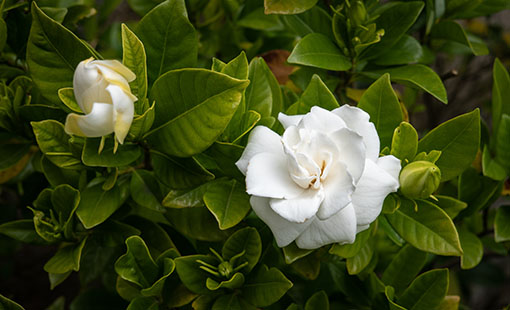
All About Gardenia
Gardenia plants have beautiful, fragrant white flowers that are a symbol of trust and clarity, making them a lovely addition to any garden or home. With a few simple tips in mind, caring for these unique flowers is a breeze, especially in the summertime!
Overview
Gardenia flowers carry a sweet and light aroma that can be recognized immediately by anyone who has ever smelled it before. Known for their glossy green leaves and white flowers, gardenias are popular blooms commonly found in the Southern region of the United States. However, these flowers are native to the tropical and subtropical regions of Asia and Africa.
There are over 142 species of gardenia plants that have been growing in places like China and Japan for thousands of years. They are also common in Polynesia, where people often use the flowers as necklaces due to their highly fragrant scent. Some Polynesian islands even use these flowers to indicate one’s relationship status — when the flower is worn on the right ear, the person is single, and the left ear means they are in a relationship!
The flower was named “gardenia” by John Ellis, who named it after the amateur botanist Alexander Garden in the 18th century. Shortly after the flower was introduced to the United States, gardenias began gaining more popularity, especially in the South.
Care
Gardenias are lovely summer flowers that are perfect for those who want a sweetly scented garden in their home. However, they are often considered a difficult plant to take care of and it’s recommended that gardeners start with small plants without buds to allow them to adjust to a new home. Doing so will ensure that the buds will eventually grow into beautiful flowers.
Sunlight
Gardenia plants should be placed in full sun for a few hours during the day, but partial shade is appreciated, especially during the summer months. If your plant receives too much direct sunlight, the buds may fall off or the leaves will scorch.
Water
Keeping the soil constantly moist is key to a gardenia’s health. Water the plant thoroughly until water drips through the drainage holes at the bottom of the pot. During the winter months, reduce watering to every couple of weeks.
Temperature
Gardenias thrive in 70 F during the day and about 60 F at night. Since they are considered tropical plants, they perform best in warmer temperatures and can be fussy if conditions aren’t ideal.
Toxicity
Though gardenias are nontoxic to humans, they can be mildly toxic to animals. The flowers, leaves and stems contain geniposide and gardenoside, toxins that cause mild to severe gastrointestinal upset in dogs and cats.
Pests & Problems
Pests: Even when grown under the best conditions, gardenias are still susceptible to a variety of plant pests and insects. To name a few, these flowers attract scales, whiteflies, aphids and spider mites. In cases like this, prune out any infested foliage and spray your plant with water to wash off the pests. If that doesn’t work, you can always opt for chemical controls and insecticides to get the job done.
Problems: Like many other plants, gardenias are prone to root disease, which is usually caused by fungus. To prevent this from happening, be sure your soil is well-drained and provide good air circulation for your plant. Other diseases that are commonly found in gardenias include bud drop, stem canker and powdery mildew.
Repotting & Propagation
Repotting: The easiest way to tell when your plant needs to be repotted is if the roots begin growing from the bottom of the container. To avoid damaging any buds or foliage, wait until late spring to early summer to switch pots. Choose a container that’s approximately 1-2 inches larger in diameter and make sure it has drainage holes to allow any excess water to seep through.
Propagation: The best time to propagate gardenias is in early spring with 3-4 inch stem cuttings. Remove the lower leaves and keep the cuttings moist by placing them in a perlite soil mixture. Place the plant in bright, indirect light and you’ll begin to see the plant root in about four to eight weeks.
FAQs
Since gardenias aren’t the easiest plant to take care of, you may be scratching your head wondering where to start. Below are some common questions about gardenia flower care and their life cycle to help you become a gardenia savant.
Do gardenias need sun or shade?
Though gardenias like full sun, they can be sensitive to direct heat, especially in the summer months. On warmer days, provide partial shade to your gardenias — this will ensure the leaves don’t get scorched and the buds will bloom.
How do you keep gardenias blooming?
In order to maximize the number of buds you’re getting from your gardenia plant, you’ll want to make sure the soil is moist and well-drained. Water is essential for flower development, so be sure to water the plant anytime the soil starts to feel dry, every one to two weeks.
Do gardenias like coffee grounds?
Yes! Coffee grounds make for a great homemade gardenia fertilizer since they are rich in potassium, magnesium and nitrogen. Simply collect any leftover coffee grounds from your morning cup of joe and spread them around the base of the plant. The coffee works to lower the pH in the surrounding soil, which is great for the acid-loving gardenia!
Do gardenias do well in pots?
Gardenias are great options if you’re looking for a plant that does well in containers. Keeping your gardenias in a pot will make it easier when you need to move the plant around based on the amount of sun it’s getting, especially during the summertime. Once it’s wintertime, it can be brought indoors to avoid the cold weather.
Information courtesy of FTD.com

 Adams Fairacre Farms
Adams Fairacre Farms